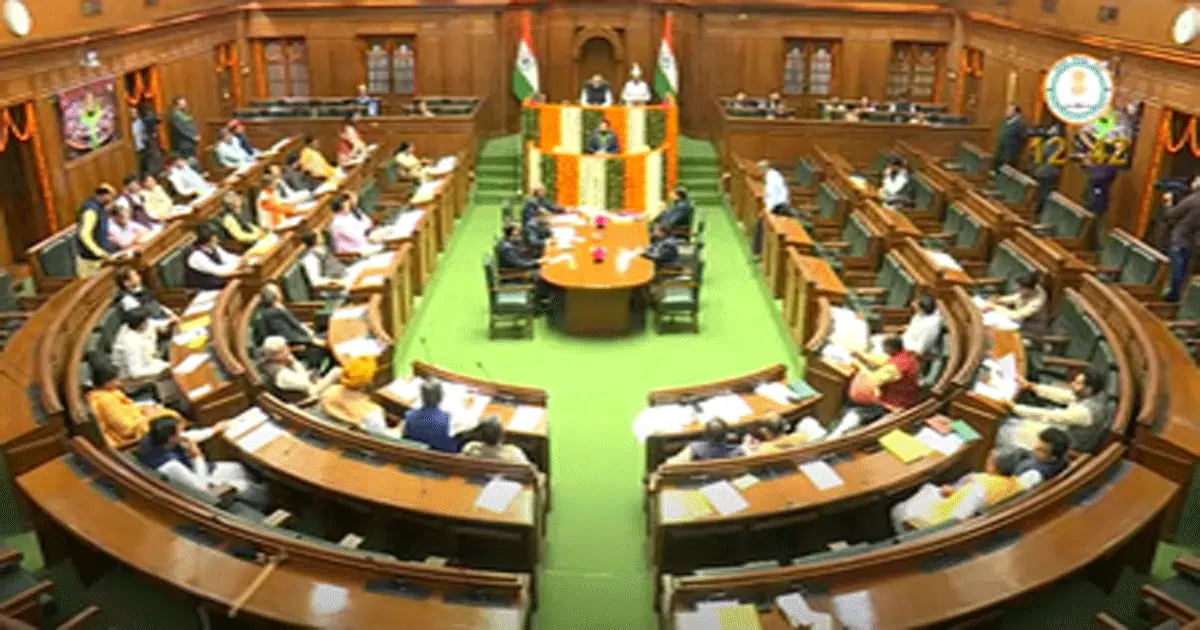National News
CAG report on Delhi’s health services tabled in Assembly

New Delhi, Feb 28: The Comptroller and Auditor General (CAG) report on health services in the national Capital, during the erstwhile AAP government’s regime, was tabled in the Delhi Assembly on Friday.
The Central government auditor’s report on the health department’s expenses under the AAP dispensation, is one of the dozens of reports that the BJP government has vowed to present in the House, to expose corruption under the previous regime.
In the CAG report tabled on Friday, the Mohalla Clinics, one of the flagship projects of the Kejriwal administration as well as government hospitals came under scathing criticism for the gross irregularities, inefficiencies, price escalation and under-utilisation of funds.
A couple of BJP legislators, speaking on the CAG report in the Assembly, tore into the former AAP government and accused it of promoting corruption and malpractices in health departments.
BJP MLA Harish Khurana slammed the AAP government over cost escalation and overpricing of several projects, due to delays.
He said that the CAG report clearly shows the array of irregularities that took place under the AAP government.
“In 11 years of their rule, they built just three hospitals and also incurred huge losses to the exchequer. In 11 years of their governance, only 3 hospitals were either built or extended. Indira Gandhi hospital suffered 5 years’ delay, leading to escalation in cost by Rs 314 crore. Similarly, Burari hospital saw cost escalation by about Rs 41 crore,” Khurana said.
“In total, an additional expense of Rs 382 crore was made on construction of three hospitals,” he pointed out.
“The funds provided by the Centre to the state government in fighting the Covid pandemic were also mismanaged. They were blaming the Centre over shortage of funds but the facts reveal that state government was responsible for bungling up,” said Khurana, son of former Delhi CM Madan Lal Khurana.
The CAG report highlights the ‘dire conditions’ of Mohalla Clinics, the much-touted dispensaries started under the stewardship of former Delhi CM Arvind Kejriwal.
Earlier in the day, AAP leaders protested outside the Assembly against the suspension of 21 lawmakers, this week. Ex-Chief Minister Atishi, now Leader of Opposition, also wrote to Speaker Vijender Gupta to flag the ‘severe blow to democratic values’.
Business
Maharashtra on path to becoming GCC hub: CM Fadnavis

Nagpur, Dec 12: Chief Minister Devendra Fadnavis on Friday announced that a crucial milestone has been achieved in the journey to establish Maharashtra as a GCC (Global Capability Centre) Hub.
He said that the Brookfield company is set to build Asia’s largest Global Capability Centre (GCC) in Mumbai, spanning approximately 2 million square feet.
The Chief Minister said that this project is expected to generate a total of 45,000 jobs, including 15,000 direct and 30,000 indirect jobs.
He stated that due to the state’s talent pool, infrastructure, and industry-friendly environment, Maharashtra is becoming a preferred destination for Global Capability Centres.
“The new GCC policy will lead to large-scale skill-based job creation and economic growth,” he added.
He also mentioned that FedEx, a global leader in the logistics sector, is keen to invest in its GCC and other operations near the Mumbai-Navi Mumbai airport area, said the government release.
The Chief Minister informed that he requested Microsoft to consider Maharashtra for their investments, noting that their largest existing investment is already in the state.
He expressed confidence that Microsoft will make a major investment in the future and take the lead in making Maharashtra an Artificial Intelligence (AI) centre.
The Chief Minister said that Maharashtra’s model for crime control with the help of Artificial Intelligence is a guiding light for the entire country.
Chief Minister Fadnavis confirmed that Microsoft has assured priority to Maharashtra in their largest ever investment in India, amounting to $17 billion.
He further highlighted the ‘Marble’ platform developed by Maharashtra, which helps detect cyber and financial crimes in just 24 hours instead of 3-4 months.
He said that this has resulted in saving people’s money and has expedited the process of tracking criminals.
Crime
Bihar: Robbers posing as police steal goats purchased under CM’s scheme

Patna, Dec 12: A shocking incident has emerged from Samastipur’s Vidyapati police station area, where four men posing as police personnel stole goats purchased under Chief Minister Nitish Kumar’s Women’s Employment Scheme.
The incident occurred on Friday in Dhaneshwarpur South Panchayat, Ward No. 9, when the victim, Champa Devi and her family were asleep.
Suddenly, a four-wheeler pulled up outside their home, and the men inside woke the family.
Claiming they were police officials searching for a liquor mafia suspect, the men forcibly entered the premises.
Inside, they took away four goats that Champa Devi had bought using the Rs 10,000 financial assistance she received under the Women’s Employment Scheme.
When she tried to stop them, the accused reportedly brandished a pistol, abused her, and threatened to kill her.
“They said they were police and that a liquor mafia had passed that way. They showed a pistol and told us to move aside. Fearing for our lives, we stepped back. They loaded all four goats into their vehicle and fled,” said Champa Devi.
The same group allegedly targeted another house nearby, stealing three more goats.
According to the victims, they too had purchased the goats with government assistance.
Before the villagers could understand what was happening, the thieves fled in their vehicle with all seven goats.
Locals have demanded strict police action. However, Vidyapati police said they are awaiting a formal complaint to begin proceedings.
“A report of theft has been received, but no application has been filed yet. Action will be taken as soon as we receive it. The gang involved is being investigated,” said Suraj Kumar, Police Officer, Vidyapati Police Station.
The area has witnessed several such goat thefts in the past. Thieves often arrive in four-wheelers—not on motorcycles or on foot—making quick escapes difficult to track.
In an earlier incident a few years ago, villagers even held a DSP hostage after mistaking him for a goat thief.
Under Chief Minister Nitish Kumar’s Women’s Employment Scheme, women are provided Rs 10,000 each to start income-generating activities.
So far, 1.56 lakh women have received the amount. After six months of evaluation, beneficiaries showing positive outcomes become eligible for Rs 2 lakh in additional support to expand their ventures.
Business
India’s CPI inflation estimated at 0.71 pc for Nov, food inflation stays in negative zone

New Delhi, Dec 12: India’s year-on-year inflation rate, based on the Consumer Price Index (CPI), was estimated at 0.71 per cent for November this year which was marginally higher than the 0.25 per cent in October, according to figures released by the Ministry of Statistics on Friday.
Food inflation stayed in the negative zone during November at (-) 3.91 per cent as prices of food goods fell compared to the same month of the previous year. Food inflation has now stayed negative for the sixth month in a row, easing the burden on household budgets.
However, the increase in headline inflation during November 2025 is mainly attributed to an increase in the inflation of vegetables, eggs, meat and fish, spices, and fuels compared to October, according to an official statement.
The retail inflation had eased further in October, after having plummeted to an over 8-year low of 1.54 per cent in September, as prices of food items and goods across sectors fell during the month.
The declining trend in food prices continued in October as food inflation fell deeper in the negative zone at (-) 5.02 per cent from (-) 2.28 per cent in September.
However, the overall outlook for inflation remains benign.
The RBI’s monetary policy committee (MPC) last week slashed its forecast for India’s inflation rate for the financial year 2025-26 to 2 per cent from 2.6 per cent predicted in October due to the sharp decline in food prices and the GST rate cuts playing out.
RBI Governor Sanjay Malhotra announced a reduction in the repo rate by 25 basis points to 5.25 per cent from 5.5 per cent earlier, as inflation had come down and the monetary policy could focus on boosting growth.
Malhotra said that the surge in economic growth to 8.2 per cent in the second quarter of the current financial year and the sharp decline in inflation to 1.7 per cent had provided a rare “Goldilocks period” for the Indian economy.
“The MPC noted that headline inflation has eased significantly and is likely to be softer than the earlier projections, primarily on account of the exceptionally benign food prices. Reflecting these favourable conditions, the projections for average headline inflation in 2025-26 and Q1:2026-27 have been further revised downwards.”
Malhotra also pointed out that core inflation (which excludes food and fuel) remained largely contained in September-October, despite continued price pressures exerted by precious metals. Excluding gold, core inflation moderated to 2.6 per cent in October. Overall, the decline in inflation has become more generalised, he added.
The RBI Governor observed that food supply prospects have improved on the back of higher kharif production, healthy rabi sowing, adequate reservoir levels and conducive soil moisture. Barring some metals, international commodity prices are likely to moderate going forward.
-

 Crime3 years ago
Crime3 years agoClass 10 student jumps to death in Jaipur
-

 Maharashtra1 year ago
Maharashtra1 year agoMumbai Local Train Update: Central Railway’s New Timetable Comes Into Effect; Check Full List Of Revised Timings & Stations
-

 Maharashtra1 year ago
Maharashtra1 year agoMumbai To Go Toll-Free Tonight! Maharashtra Govt Announces Complete Toll Waiver For Light Motor Vehicles At All 5 Entry Points Of City
-

 Maharashtra1 year ago
Maharashtra1 year agoFalse photo of Imtiaz Jaleel’s rally, exposing the fooling conspiracy
-

 National News1 year ago
National News1 year agoMinistry of Railways rolls out Special Drive 4.0 with focus on digitisation, cleanliness, inclusiveness and grievance redressal
-

 Maharashtra1 year ago
Maharashtra1 year agoMaharashtra Elections 2024: Mumbai Metro & BEST Services Extended Till Midnight On Voting Day
-

 National News1 year ago
National News1 year agoJ&K: 4 Jawans Killed, 28 Injured After Bus Carrying BSF Personnel For Poll Duty Falls Into Gorge In Budgam; Terrifying Visuals Surface
-

 Crime1 year ago
Crime1 year agoBaba Siddique Murder: Mumbai Police Unable To Get Lawrence Bishnoi Custody Due To Home Ministry Order, Says Report












